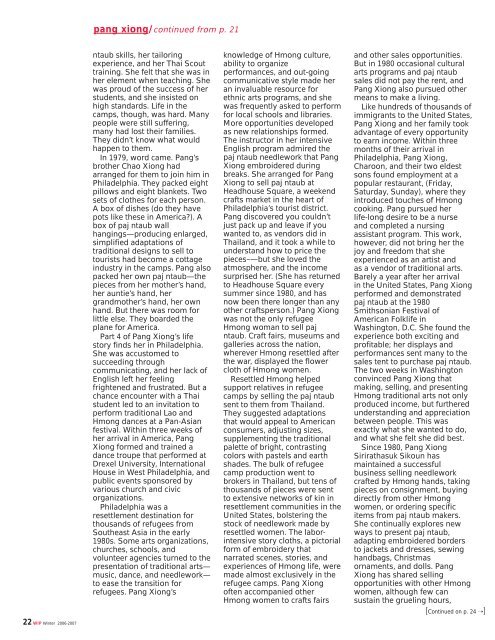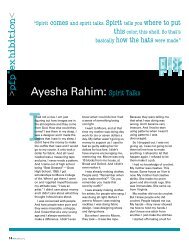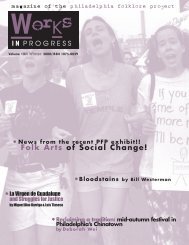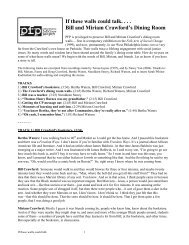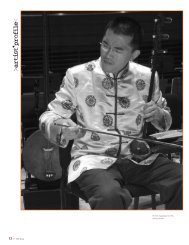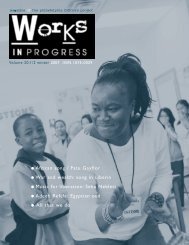View PDF - Philadelphia Folklore Project
View PDF - Philadelphia Folklore Project
View PDF - Philadelphia Folklore Project
- No tags were found...
You also want an ePaper? Increase the reach of your titles
YUMPU automatically turns print PDFs into web optimized ePapers that Google loves.
pang xiong/continued from p. 21ntaub skills, her tailoringexperience, and her Thai Scouttraining. She felt that she was inher element when teaching. Shewas proud of the success of herstudents, and she insisted onhigh standards. Life in thecamps, though, was hard. Manypeople were still suffering,many had lost their families.They didn’t know what wouldhappen to them.In 1979, word came. Pang’sbrother Chao Xiong hadarranged for them to join him in<strong>Philadelphia</strong>. They packed eightpillows and eight blankets. Twosets of clothes for each person.A box of dishes (do they havepots like these in America?). Abox of paj ntaub wallhangings—producing enlarged,simplified adaptations oftraditional designs to sell totourists had become a cottageindustry in the camps. Pang alsopacked her own paj ntaub—thepieces from her mother’s hand,her auntie’s hand, hergrandmother’s hand, her ownhand. But there was room forlittle else. They boarded theplane for America.Part 4 of Pang Xiong’s lifestory finds her in <strong>Philadelphia</strong>.She was accustomed tosucceeding throughcommunicating, and her lack ofEnglish left her feelingfrightened and frustrated. But achance encounter with a Thaistudent led to an invitation toperform traditional Lao andHmong dances at a Pan-Asianfestival. Within three weeks ofher arrival in America, PangXiong formed and trained adance troupe that performed atDrexel University, InternationalHouse in West <strong>Philadelphia</strong>, andpublic events sponsored byvarious church and civicorganizations.<strong>Philadelphia</strong> was aresettlement destination forthousands of refugees fromSoutheast Asia in the early1980s. Some arts organizations,churches, schools, andvolunteer agencies turned to thepresentation of traditional arts—music, dance, and needlework—to ease the transition forrefugees. Pang Xiong’sknowledge of Hmong culture,ability to organizeperformances, and out-goingcommunicative style made heran invaluable resource forethnic arts programs, and shewas frequently asked to performfor local schools and libraries.More opportunities developedas new relationships formed.The instructor in her intensiveEnglish program admired thepaj ntaub needlework that PangXiong embroidered duringbreaks. She arranged for PangXiong to sell paj ntaub atHeadhouse Square, a weekendcrafts market in the heart of<strong>Philadelphia</strong>’s tourist district.Pang discovered you couldn’tjust pack up and leave if youwanted to, as vendors did inThailand, and it took a while tounderstand how to price thepieces–—but she loved theatmosphere, and the incomesurprised her. (She has returnedto Headhouse Square everysummer since 1980, and hasnow been there longer than anyother craftsperson.) Pang Xiongwas not the only refugeeHmong woman to sell pajntaub. Craft fairs, museums andgalleries across the nation,wherever Hmong resettled afterthe war, displayed the flowercloth of Hmong women.Resettled Hmong helpedsupport relatives in refugeecamps by selling the paj ntaubsent to them from Thailand.They suggested adaptationsthat would appeal to Americanconsumers, adjusting sizes,supplementing the traditionalpalette of bright, contrastingcolors with pastels and earthshades. The bulk of refugeecamp production went tobrokers in Thailand, but tens ofthousands of pieces were sentto extensive networks of kin inresettlement communities in theUnited States, bolstering thestock of needlework made byresettled women. The laborintensivestory cloths, a pictorialform of embroidery thatnarrated scenes, stories, andexperiences of Hmong life, weremade almost exclusively in therefugee camps. Pang Xiongoften accompanied otherHmong women to crafts fairsand other sales opportunities.But in 1980 occasional culturalarts programs and paj ntaubsales did not pay the rent, andPang Xiong also pursued othermeans to make a living.Like hundreds of thousands ofimmigrants to the United States,Pang Xiong and her family tookadvantage of every opportunityto earn income. Within threemonths of their arrival in<strong>Philadelphia</strong>, Pang Xiong,Charoon, and their two eldestsons found employment at apopular restaurant, (Friday,Saturday, Sunday), where theyintroduced touches of Hmongcooking. Pang pursued herlife-long desire to be a nurseand completed a nursingassistant program. This work,however, did not bring her thejoy and freedom that sheexperienced as an artist andas a vendor of traditional arts.Barely a year after her arrivalin the United States, Pang Xiongperformed and demonstratedpaj ntaub at the 1980Smithsonian Festival ofAmerican Folklife inWashington, D.C. She found theexperience both exciting andprofitable; her displays andperformances sent many to thesales tent to purchase paj ntaub.The two weeks in Washingtonconvinced Pang Xiong thatmaking, selling, and presentingHmong traditional arts not onlyproduced income, but furtheredunderstanding and appreciationbetween people. This wasexactly what she wanted to do,and what she felt she did best.Since 1980, Pang XiongSirirathasuk Sikoun hasmaintained a successfulbusiness selling needleworkcrafted by Hmong hands, takingpieces on consignment, buyingdirectly from other Hmongwomen, or ordering specificitems from paj ntaub makers.She continually explores newways to present paj ntaub,adapting embroidered bordersto jackets and dresses, sewinghandbags, Christmasornaments, and dolls. PangXiong has shared sellingopportunities with other Hmongwomen, although few cansustain the grueling hours,[Continued on p. 24 ➝]22 WIP Winter 2006-2007


